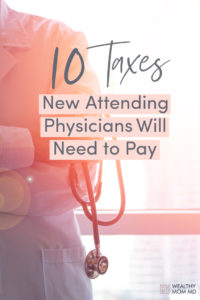Money
Loving what you do is essential to having a successful career, but what happens when your goals and priorities start to shift as you age and grow? At that moment you may realize “working until you die” isn't on your radar anymore. As a woman physician, this is where taking control of your finances now will have an everlasting impact on your happiness in the future.
Whether you’re just entering the field or you’ve been practicing medicine for years as a woman physician, you need to take control of your finances. This isn’t just about paying off debt or understanding bank account balances. Women physicians should pursue the path to financial independence from the start of their careers.
Read all the major reasons why women physicians need to start taking control of their finances on KevinMD.

Have you ever considered that your mindset affects how you experience life?
For those of us that are mothers, we all gave birth to a baby. But speak to 10 mothers and you’ll get 10 different stories about how their first year went.
Do you have a wealthy or growth mindset or a poor or fixed mindset when it comes to money?
You may have a poor mindset if you have thoughts like:
“I’ll never have enough money”
“I can’t afford it”
“I can’t do [ insert vacation or other want here ] because I don’t have money”
“I chose the wrong [ lower paying ] specialty and now I will never be able to retire”
“I can’t afford to take a risk and lose all of my money”
You are deeply afraid of change. You may be so frugal to the point of deprivation despite having a very high income (and perhaps driving your partner a bit crazy …)
You may have a wealthy mindset if you have thoughts like:
“There is more than enough”
“I’m responsible for creating money”
“I love money”
You know that taking risks is necessary in order to grow. You embrace change and adapt to it.
You’re generous with your knowledge and time. You don’t worry about “competition” because there is enough for everyone and more.
Now, most of us have had thoughts in both mindsets at any given time, but I bet you spend most of your thoughts in one of those mindsets. Our path to becoming physicians often meant being competitive and being more in that poor mindset. After all, not everyone who applied to medical school got in. There are only so many residency spots per program per specialty.
What worked to get you from college student to physician may not work for your path to financial freedom.

So here’s how to cultivate a wealthy or growth mindset:
Practice gratitude.
Yes, that thing that everyone says you should do. But are you actually doing it? If you have a journal or paper planner, start with writing down 1 thing you are grateful for every day. Don’t get stuck and think it has to be something big. I’m grateful for my hot cup of coffee every morning for example.
Do some continuing life education.
Push yourself to grow (who else will?). There are many ways to do this – books, podcasts, and live events. Two of my favourite growth mindset podcasts are Brooke Castillo’s The Life Coach School and Brendon Bouchard’s The Brendon Show. Consider working one-on-one with a trained life coach. Think of a life coach as a personal trainer for your mind. I currently work with one from Empowering Women Physicians.
Spend time with like-minded folks.
You may need to actively seek these folks if they are not a part of your circle yet. Wealthy minded people hang out with other wealthy minded people. In business, we often participate in “masterminds” which are small groups of like-minded people committed to growing their businesses (and themselves).
Notice your thoughts.
Notice the neverending commentary that is always going on in your head. What voice? YES that voice! Those are all thoughts that may or may not serve you! And guess what? YOU can create new thoughts that actually serve you. Try it!
Change your relationship to failure.
Failure is only failure if you don’t learn from it. In fact, we learn the most from our “failures.” This is SO important when it comes to your journey to financial freedom. Your student loan debt is not a failure. The fact that you haven’t taken the reigns of your finances at age XX is not a failure. Start now.

In case you haven’t heard, Miss Bonnie MD is rebranding to Wealthy Mom MD!
In about a week, Miss Bonnie MD as you know it will no longer exist and you’ll be redirected to our new website. I am super excited about the new look and feel, here’s a sneak peek.
You may be wondering – why “Wealthy Mom MD?” When I started this blog two years ago, I didn’t wake up one day thinking “I’m going to start this blog…” Initially, it was a way for me to write thoughtful posts in response to questions I saw being asked over and over again in a Facebook group. I picked Miss Bonnie MD because, well, it’s my email address! How’s that for thoughtful branding? As my blog grew and evolved, so did I.
Over the past two years, I learned a lot along with you all. I got engaged, became a stepmom to Wren and mom to Jack. I went from being over 6 figures in negative net worth to well on my way to 7 figures net worth.
I experienced some of life’s best and some of life’s worst experiences. One thing that has really stuck with me – life is short. Our time is short.
For physician moms, time seems to slip away from our fingers as we juggle doctor, mother, wife or partner, and friend. On the surface, the word wealthy is about money. The more I've learned about money, the more I've learned about the kind of freedom it can ultimately give you. Being wealthy is a way of thinking, a mindset — not a number.
That's what Wealthy Mom MD is all about. It's not just about money, it's about cultivating an approach to life. As Henry David Thoreau said, “Wealth is the ability to fully experience life.”

Wealthy Mom MD’s mission is to empower physician moms to build wealth and create the ultimate work balance. Your ideal life will look different than someone else’s. I am here to guide you on your journey. Thank you for being here week after week making this community what it is.
And if you haven't joined yet, be sure to find the Wealthy Mom Physicians Facebook group.
Read MoreEditor's note: This is a guest post from a fellow Wealthy Mom MD, Dr. Saya Nagori. She is an ophthalmologist and the CMO/Co-Founder of the telemedicine companies SimpleContacts & SimpleHealth. She enjoys teaching women physicians about the power of choice when it comes to choosing how to practice medicine in the modern world. Both of her companies resemble her tenacity in sharing knowledge about healthcare and also taking care of the needs of women in general. Enjoy!
I love talking to female doctors about telemedicine. I love talking to anyone really about telemedicine, but especially women physicians. We have different needs and face challenges that sometimes men do not. I gave a talk at the Women in Ophthalmology National Conference last year about how telemedicine for women specifically is so powerful. I want to share a few highlights that I'm sure you'll benefit learning about.
1) Telemedicine Gives You Freedom
There are so many ways to practice telemedicine. Physicians do not necessarily need to practice it 100% of the time. You can work as a 1099 contractor for an outside company and use it to supplement your income outside your “day job.” You can obtain multiple licenses and start to practice telemedicine with limited services across the country. Or the most practical and lucrative way is to practice telemedicine on your own, and use it as an extension of your already existing practice. Imagine not having to take the day off of work when school is canceled because of a snow day. Think about the freedom you would have to continue to practice medicine virtually months after your scheduled maternity leave has ended, so you can spend more time with your new baby. What about being able to work from literally anywhere to give you the freedom to travel with your family or spend time with loved ones, and not have to sacrifice income doing it? Freedom is a great reason to practice telemedicine, isn't it?
2) You’re Probably Already Doing It
When doctors tell me they are wary of telemedicine, I remind them that when we take call or cover another physician’s patients, it is, in fact, telemedicine. Now, however, we have video in many cases so the visit can be more thorough and more accurate. The reality is, physicians are already taking patient phone calls and discussing patient problems over the phone. There are now codes in existence that allow for the billing of telemedicine. It does not have to be 100% of your practice, but perhaps changing one or two days a week from in person to telemedicine, would be very easy to integrate into your career.
3) Improved Quality of Life and Less Physician Burnout
There are so many factors surrounding telemedicine that contribute to an improved quality of life and, thus, will help in decreasing physician burnout. In addition to more freedom, you will also have more time. Think about the couple, or in some cases, several, extra hours in your day that you will have (if you don’t have to spend that time commuting to work). A female physician friend of mine used to have to strap on her breast pump during her commute (it was just over 1 hour each way) because she literally just could not find any other time to do it. She actually got pulled over by a cop once during this time, and it was quite an ordeal, to say the least. In addition to a stressful commute, the hospital and a busy clinic can be a tense environment to be in all day. Even if you are not directly engaging with all the noise in the background, it has an impact on you. The peace and quiet of your home or an environment that you can control can greatly help in sustaining your love of medicine for many years. If you could have all the positives and none of the negatives of being a physician, you may never burnout!
4) Growth Is Inevitable
Data shows that millennials (the population that we will be treating as they age for the next 40 years) want telehealth options. In fact, if their issue could be resolved with a telemedicine visit, they would actually prefer it. I think that as time progresses, and reimbursement becomes more widespread, physicians will prefer it as well. With technology improving, and more states adopting pro-telemedicine legislation, the time is ripe to get started in telemedicine. Set yourself up now so you are ahead of the game, and start enjoying the freedom of telemedicine. I agree with Bonnie when she says that “wealthy” is a state of mind. For me, practicing telemedicine has reduced my stress level and has been rewarding for me leaps and bounds beyond the paycheck I get from it. I saw myself on the path to burning out before I started practicing telemedicine, and now my quality of life has improved drastically. Not having to commute, making a healthy lunch every day, squeezing in a workout when a patient cancels, and being an overall happier person for my husband has added so much wealth to my Wealthy MD life. Now I just need to get the Mom part figured out. 🙂 Editor's note: Wow – great insight from one of the better-known women in telemedicine, don't you think? What's stopping you from following a similar path? I bet it's something like – “this sounds awesome, but how do I even get started?” Well, we got you :). Dr. Nagori has created a course for physicians on how to get started in telemedicine. Not only will she walk you through all the steps — you'll also get support from her through a private Facebook group. “How to Get Started in Telemedicine: Masterclass for US Physicians” is the only comprehensive introductory course on telemedicine and health technology in the United States. Join physicians from all over the country who are learning how to incorporate telemedicine into their practice. In addition to the basics, the course teaches the different types of telemedicine you can use in your practice, it teaches navigating reimbursement for telemedicine, it helps you to understand the regulatory environment in digital app development, and it helps you to understand the legality of telemedicine in different states. Upon completion, you will have the knowledge and framework to get started in telemedicine right away. Use code: WEALTHYMOMMD for $50 off the course! If you've taken the course, we'd love to hear your thoughts!
Read More
Here are the 5 things every stay at home spouse needs to do to protect themselves financially:
1. Save for Retirement
Most retirement accounts are tied to a job. The only tax-advantaged retirement account available to stay at home spouses is the spousal Roth IRA. This is simply the stay at home spouse opening up a Roth IRA without needing to prove earned income. For this to work, the working spouse needs to have enough income to fund both Roth IRAs. Of course, many stay at home spouses often have part-time jobs or a side hustles. This opens up other opportunities for them. Whether they make a significant income from it or not, this will give them the ability to open and fund a solo 401(k).
2. Get Life Insurance
You may have read that life insurance is only necessary for income replacement. Therefore, conventional wisdom sometimes states that someone who does not bring in an income does not need life insurance. This could not be farther from the truth for a stay at home spouse. The stay at home spouse may not get a paycheck to stay home, but they are performing a job. In fact, they are performing many jobs. Consider this: In the event of their death, the working spouse, now widowed, will need to pay for high-quality childcare, maintain the household responsibilities, and perform the additional mental load of maintaining all logistics. And let’s be honest. I doubt the working spouse will want to return to work immediately after a tragedy. The surviving family may also require support in the form of therapy as well. Obviously, when you consider this perspective, life insurance is a no brainer. The stay at home spouse needs enough term life insurance to cover the cost of the above situation. Additionally, life insurance can also give the surviving spouse more choice. For instance, the spouse who worked full time outside the home might want the ability to go part-time since now there is one less spouse to help with the family. A.L, a physician and mother, said:
My late husband got term life insurance early as a resident. We got an amount that was supposed to get me through the rest of med school and residency. Now, it will be college funds for my 3 kids. I feel SO lucky we had it in place when he was diagnosed (and ultimately passed) with his brain tumor.
3. Get It In Writing
The biggest financial risk of being a stay at home parent is divorce. As a result, the decision to have one partner become a stay at home parent must be a mutual decision. Often, couples are already married when they come to this decision. It is important for the stay at home spouse to have protection against divorce. Being out of the workforce for years poses a real financial risk. For some fields, leaving is career suicide. He or she is sacrificing peak earnings potential and forgoing career advancement. They are also giving up building up Social Security savings and retirement contributions. A postnuptial agreement is a must for couples who choose to have a stay at home spouse to protect that spouse. And yes, that will probably mean an alimony provision. To better understand what exactly a working partner is sacrificing by staying home, the Center for American Progress put together this calculator that can help these conversations focus on numbers, rather than emotions.
4. Understand Disability Insurance
Most people have disability insurance tied to their employer. Additionally, most doctors should have private own occupation disability insurance. Stay at home spouses cannot purchase disability insurance unless they have earned income such as a home business. (Note: A quick google search finds one company offering such a policy, but it seems rare otherwise). But, if they had a private policy before staying at home, they can keep it. Also, once a spouse is out of the workforce for 10 years, he or she may not be eligible for Social Security disability insurance. This is another reason why a postnuptial agreement is a must for stay at home spouses.
5. Hone Skills & Consider Part-Time Work
Another important thing to remember with the finances of stay at home spouses is that the situation can change over time. As the kids get older and spend more time in school and activities, the stay at home parent will have more time to pursue outside interests. Those interests might be a hobby, a part-time job, or a side hustle. This is a great way for the stay at home parent to flex their brain in new ways and maybe even bring home some income. Remember if your stay at home partner does decide to monetize their side hustle, they have the option of opening that solo 401(k).
Final Thoughts on Finances of Stay at Home Spouses
We often talk about financial protection in terms of paychecks. But what do you do when your job doesn't come with a paycheck? Stay at home spouses perform vital roles for their families, which is why it is so important to give special consideration to their finances. Making these five considerations will keep your stay at home spouse protected financially. Do you have tips to share about stay at home spouses?
Read More Physician moms are often the higher earner in their relationships. As the breadwinner, it can sometimes be a challenge managing our money with our partner without feeding resentment. How does a breadwinning woman bring home the bacon and have a thriving family and personal life? How does she strike this balance when she makes more? Is that even possible?
“Female breadwinners are on the rise, society still expects men to take the financial lead as breadwinners in their households.”
Agree? Thankfully, Farnoosh Torabi was brave enough to start tackling this subject that needs to be talked about in her book When She Makes More. Women are now making lots of money, but traditional gender roles still permeate our culture. I am a firm believer in looking at all the money as our money vs. mine and yours. However, it’s clear that when one person contributes more than the other, this money disparity often brews resentment. When Matt and I first started merging our finances, we started working with a flat fee financial advisor. This is a great use of a financial advisor, who serves as a third party money expert. The advisor can help iron out any differences and make suggestions that the other party won’t take personally.
About the Author
Farnoosh is a leading expert on finance with roots in journalism. After her first book release in 2008, she also found herself coaching Americans through money issues on shows like REAL SIMPLE, REAL LIFE. As she created more career wins for herself, she also grew her family. By the time Farnoosh was in her 30s, she realized that she was the breadwinner…and so are so many other women. That's the impetus for this book. I first discovered Farnoosh through her acclaimed podcast So Money. I felt like “I made it” when she featured me on her podcast to discuss women physicians and personal finance. 
Summary of When She Makes More
Farnoosh conducted social research with Dr. Brad Klontz, a financial psychologist and certified financial planner. They developed a survey and interviewed over 1,000 heterosexual women in committed relationships. There was an even split between women who make more than their partners and women who make less. 80% of the women interviewed held a college degree or higher. In the book, she walks readers through the 10 rules breadwinning women need to live by to make relationships and life work based on her research.
A Culture That Isn't Ready for Breadwinning Women
Farnoosh initially tackles what we already know. She also says that ignoring the fact that there are cultural and societal “norms” can be at your peril. The social culture still favors traditional gender roles. Friends and family might not say it, but they will still question when the perceived finances of a couple buck those trends. Society at large just isn’t comfortable with a breadwinning woman. I can hear my Korean mother disapproving of my choices when I was dating. She would use her preconception of their earning power and make comparisons to that of her soon-to-be doctor daughter (me!). Farnoosh recommends working with your partner to “Rewrite the Fairytale.” This allows you to define your rules as a couple.
Managing Finances
When a woman makes more, that woman is more likely to be the primary decision-maker on all things money, like paying bills, budgeting, saving, and planning for retirement. Many of the surveyed women wished that their partner would participate more in handling the finances. Even if you earn less as a woman, Farnoosh says women need to stay involved in the finances and know where their money is going. Farnoosh recommends three buckets of money: his, hers and ours. In the book, she candidly discusses how she and her husband manage their finances.
Quality of Relationships
When She Makes More also reveals some tension in the relationships of female breadwinners. Couples often report less satisfaction in their relationship. Breadwinning women are more likely to get divorced as well. The reasons are multifaceted, but one of the reasons is due to an often lopsided division of the household chores and logistics. Can I get an AMEN? Us physician moms know all too well that we are often a physician, primary parent, cleaning lady, vacation planner, and at-home chef all at once. Farnoosh's tip? Hire a wife! I couldn't agree more. She also warns that the thought Am I better off without you? is a deadly missile and may begin the demise of your relationship.
Career Expectations
When a woman earns more, she often feels a lot more pressure about being the main breadwinner. She feels the stress of having to maintain her income. She might also feel guilty about not having more time with her family. Of course, my tip is to take charge of your finances and set yourself and your family up to work towards financial independence and true wealth.
What I Loved
My favorite tips and insights from Faroosh's book are: The concept of instituting yours, mine and ours accounts. This is how Matt and I handle our “pots” of money. Overall, we look at it as “one pot.” I also love her tip about allocating his money to specific tasks such as funding your children's education. I am a huge fan of the idea of buying yourself a wife. Outsource as many household tasks as possible to bring more peace and happiness to the relationship. She also discusses prenups, which are an essential part of any marriage. Of course, if you don't have a prenup, it's not too late. Post-nups can also be very helpful to keep couples on the same page. Lastly, she points out something I think many couples overlook when they decide to have one of them stay home: The numbers may work out to have a stay at home spouse in the short term, but it may not be the best financial decision long-term since a long break from work is essentially committing career suicide in certain fields.
Who This Book is for
This book isn't just for breadwinning ladies! It's actually an important read for families of any financial makeup. Why? Because you never know when the breadwinner status might shift. From temporary disabilities and career changes to reducing hours or taking a leave to help with family, you never know when your role might shift and when your partner's role might shift. That means you also can't always predict if and when you might take on the breadwinner role.
Plus, the more perspectives you hear about how couples share their money and deal with financial conflict, the stronger your relationship becomes. Whether you're the primary breadwinner or not, you can use When She Makes More to reflect on the money dynamics in your current relationship.
Read MoreIs the grass greener on the other side? Who really wins when it comes to a 1099 vs W2?
This is a guest post by Dr. Barbara Hamilton who blogs at Tired Super Heroine. She is an interventional radiologist who writes about the challenges of being a physician and mother.
I was an employee and received a W2 during my first three years out of training. At the time, I was working in private practice as a diagnostic and interventional radiologist in California. Working for a national company, I was told that I did not fit the definition of independent contractor (IC), since I had little control over my schedule (sob!). The practice managers felt that IC status would not stand up to IRS scrutiny in my case. Eventually, the radiology company was bought out. As a result, I started working as an IC.
Here are some things I have learned in my first year of earning a 1099 and forming a professional S-corporation.
Different Employee Benefits
While salary is often the first thing people consider when it comes to employment, understanding the different benefits that come from 1099 vs. W2 work is key.
Stability in W2 Work
A co-worker of mine has chosen to remain a W2 employee for the sake of simplicity. He counts on a paycheck every 2 weeks. He does not have to keep track of separate corporate accounts or itemize business expenses. Consider whether you value the simplicity of being an employee over the increased responsibility that comes with self- employment.
Will your status change whether you must pay for your own malpractice coverage? My current group provides malpractice coverage for employees and contractors alike. This may not be the case for you. Liability coverage would be a large business deduction for a 1099 earner, but it would also be a significant expense to account for when negotiating increased 1099 wages.
Evaluating Benefits Packages
As an employee, you receive a benefits package, which has monetary value beyond the salary provided. Often, one of the most significant benefits is access to employer sponsored group health insurance. I was not thrilled with our plan options as an employee, and I still paid a significant amount of the premium. A group life insurance policy was provided free of charge, but it was inadequate on its own. Group disability insurance was provided, but the benefit would be limited to one year, so I still needed my own long term disability policy. Given these factors, the benefits offered were not compelling enough to keep me as a W2 employee.
As an IC, I now see that healthcare options can also be limited due to geographic constraints. Premiums run about $1000 per month for my family of three. We do not qualify for a government subsidy, so we have an off-exchange PPO. With an S-corp, I am able to deduct premiums from our personal return. A C-corp, on the other hand, can deduct these as a business expense. This deduction will be of questionable benefit for us. Previously, I paid half our premiums via payroll deduction. The healthcare equation may look different for you. For example, being employed at a large academic institution, you may receive truly excellent coverage or even free healthcare, as I did during fellowship. This is a valuable benefit for some employees.
Retirement Benefit Options
Some W2 earners will receive a match to their 401k contributions. I received Safe Harbor contributions as an employee, amounting up to $10,600 one year. However, 401k contribution limits were $18,000 in 2018. This limited my ability to decrease taxable income. As a 1099 earner and business owner, I can contribute to a solo 401k as both the employee and the employer, with a combined contribution limit of $55,000 this year. This larger contribution limit will allow me to significantly reduce my taxable income, and more than double my 401k savings rate, even accounting for the Safe Harbor contributions I will lose. This is one of the most compelling reasons I chose to switch to IC.
Professional Development and Continued Learning
As an employee, you may get a stipend to pay for continuing medical education, CME. This is a wonderful benefit because it is money on which you do not pay income tax. This makes it worth more than if you simply added it to your total compensation. I did not receive a CME stipend as an employee. As an IC, I can now easily deduct airfare, lodging, course fees, and other CME related expenses on schedule C.
Revised Tax Law Implications
Standard deductions for personal income taxes have risen with the new tax law. These are now $12,000 for individuals, and $24,000 for married couples filing jointly. This means that if you are paying for any unreimbursed business expenses as an employee, it will now be even harder for you to recoup any money in the form of a tax deduction.
As an IC, I plan to deduct many business expenses. Filing a corporate return this year will increase the cost of tax preparation by $700. That is deductible. Some of the other deductions I’m utilizing include a new cell phone, internet service, and a home office. The latter includes a portion of our homeowner’s insurance and utility bills. Some meals are deductible. A corporation can purchase or lease a business vehicle. A large vehicle with a gross weight of 6000 lb can be fully depreciated in one year, making the purchase price deductible in that tax year. Paying your kids to model for your website can be deducted as a business expense. One can even rent their own home to the corporation for work related events.
Understanding Cash Flow in 1099 vs. W2 Work
As an employee, cash fluctuations are minimal. Paychecks arrive every other week. The employee doesn't need to take direction action since payroll deductions are taken automatically.
My company pays independent contractors monthly. Therefore, there is a longer period between checks, and the checks are larger. Since 1099 earners do not have payroll deductions taken from their income, they must pay estimated quarterly taxes. For many, these payments are large. I have paid estimated quarterly installments ranging $7,000 to $20,000 each, between state and federal taxes. I contribute lump sums to my solo 401k.
These factors can result in wild fluctuations in the corporate account, with periods of depleted cash reserves. As an employee, taxes and expenses are relatively out of sight, out of mind. As an IC, on the other hand, you have both the control and responsibility to make these expenditures, and thus are fully aware of their cost and their effect on your cash flow.
Getting Going as an S-Corp
A new business entity must be registered with the state in which it is headquartered. The optimal business entity may vary based on where you live and work. I chose an S- corporation. The application was submitted by my accountant. In the case of an S-corporation, the company must be registered as a C- corp prior to electing S- corp status. I don't make the rules. Consult your CPA.
Creating an EIN
Your corporation has an Employer ID number, or EIN, which is used as the entity’s tax ID number. When money comes into the corporation, it must be associated with the EIN, not your social security number. Likewise, the EIN is needed to set up business accounts, which are separate from your personal accounts.
Any business account bears the name of, and is owned by the corporation. This structure is required to ensure the money earned receives appropriate tax treatment. Early in the year, I made the mistake of opening a personal account for the business, not associated with my EIN. I later spent a couple of hours at the bank correcting my mistake.
Payroll Decisions
In an S-corporation, a corporate payroll is required. This costs $35 per month with an online platform I use. But note that many payroll companies charge far more. My accountant, for example, charges $80 per month, or $960 per year for this service. Payroll is a deductible business expense, but it remains beneficial to minimize it.
You need to pay your employees a “reasonable” salary. Basically, a reasonable salary is the amount you could theoretically pay someone to replace you. Some estimate this should be 30- 50% of 1099 earnings for the primary employee, say a doctor in this scenario. Using a pass through entity such as an S- corporation, you will save FICA taxes on the remaining income, which becomes corporate profit. You will still pay state and federal income tax on all corporate profit.
Running the Tax Numbers
Run some numbers. As an IC, you will pay self- employment tax, additional accounting fees, and registration fees. The state of California taxes corporate profits at 1.5% with an $800 yearly minimum franchise tax. I wanted to be sure that forming a corporation would reduce my tax liability enough to be worth the trouble because of these additional expenses. My accountant charged $500 to run some theoretical numbers through his accounting software, generating reports of various scenarios. The most important variables are the salary one chooses, and the anticipated corporate profit. Employing a spouse or other family member is an option. This involves paying extra payroll tax for that employee, but it allows them to contribute to their own retirement plan.
I found that the estimated yearly tax savings projects in the five to ten thousand dollar range for my family. Five thousand dollars multiplied by many working years, compounded over time, can add up to a large sum. Therefore, the benefits of being self- employed, relative to the effort required to learn about it, may be greatest early in one’s career. I feel I’m getting the most “bang for my buck,” since this knowledge will benefit my family for years to come.
Final Thoughts On 1099 vs W2 Work
Philosophically, I feel that becoming a 1099 earner and corporation CEO (yes, you really can have that title) has started to change my way of thinking to that of a “business owner.” Learning about my business entity relatively early in my career will allow me to optimize this strategy over time. Additionally, I appreciate the ability to control factors like benefits and business deductions. In order to embark on the self- employment path, one needs a desire to learn about the mechanics involved, and to find a team of qualified professionals to assist. This is not a do it yourself project. Even with help, I will not do everything perfectly the first year. But I’m looking forward to seeing how we did in 2018.
Please note, if you are considering Public Service Loan Forgiveness (PSLF) you should not become an independent contractor. To qualify for PSLF, you must be an employee of a non-for-profit institution.
If you want to connect with Dr. Barbara Hamilton at Tired Super Heroine on social media, you can connect with her on Facebook, Twitter, and Instagram.
Read MoreYou crushed college, medical school, and residency. You're finally looking at the light at the end of the tunnel. All of your hard work is paying off, and you cannot wait for your first attending physician paycheck. And … you may not be aware of the 10 new attending physician taxes you’re about to pay.
#1 Income Taxes
To help you have a better handle on the income taxes you will owe as a new attending physician, it is important to understand the difference between federal marginal and effective taxes. Your marginal tax bracket is the % tax you pay on the last dollar you earn. This is not the bracket you pay every dollar on. We have a graduated tax system here in the U.S. Essentially, as your income rises, so does your marginal tax rate. Based on your income, you are slotted into a tax bracket. When your income crosses a certain threshold, the amount of money over that level is then taxed at a higher rate. It is also worth noting that these brackets and rates change from time to time, so how they look in 2019 isn't how they will look forever.
Conversely, effective tax rates are calculated based on the total amount of federal income tax you actually pay. To get that calculation, you look not only at taxes taken from your income, but other factors like deductions that you may receive. Generally, this effective tax rate is lower than your marginal tax rate, but both numbers are worth knowing, especially as your income increases.
As a resident, you were probably either in the 22% or 24% marginal tax rate (federal income tax, 2018 tax tables). Your income will surely rise now, and you may find yourself in the highest marginal tax bracket, currently 37%. And depending which state you live in, you may also be slapped with an additional income tax of up to 10%. You will also pay city or local taxes in cities such as New York City and Philadelphia.
Finally, you’ll still continue to pay the 1.45% Medicare payroll tax, and a Social Security tax of 6.2% on the first $132,900 for 2019 taxes. The government seems to periodically increase this.
#2 Medicare Taxes
The additional 0.9 percent Medicare tax on wages above $200,000 for individuals ($250,000 married filing jointly), which went into effect in 2013, remains in effect for 2018. Also, the Medicare tax of 3.8 percent on investment (unearned) income for single taxpayers with modified adjusted gross income (AGI) more than $200,000 ($250,000 joint filers) still exists. As your income and investments grow, these taxes are worth remembering.
#3 Board Certification
Most of us will become board certified by our specialty to show patients that we have achieved the highest level of medical training.
The initial fees are not only steep, but then you need to arrange getting there. I paid $2,500 just to sit for my dermatology boards in Tampa, Florida. Adding in the cost of flights, hotel nights, and food increases that amount considerably. Many people will also pay for courses to prepare for this as well.
Also, this is not a one-time thing. I will need to re-certify in <10 years, which brings me to the next tax.
#4 Maintenance of Certification (MOC)
Maintenance of certification (MOC) is a relatively new thing. In fact, some physicians found themselves caught off guard by the changes in 2014. I initially thought I would just have to sit for the boards and do the annual required CME requirements for my board and the state I’m licensed in. Now, with all the extra demands placed on physicians to maintain safe patient practices, MOC was born.
What is MOC? MOC is basically extra requirements aside from re-certifying exams and annual CME requirements to maintain board certification, and you get to do this for another annual fee. MOC proponents maintain that helps physicians be better physicians. Interestingly, if you were board certified before a certain date, MOC does not apply.
#5 Medical License and DEA
Medical licenses are state specific. If you move or decide to practice in a different state, you need to apply and pay for a new state medical license. This makes sense for, say, lawyers since state laws differ. But in my opinion, this does not make any sense for physicians, since medicine does not change across state lines.
Every state pretty much asks for the same information: proof that you finished all the requirements of medical school and residency, passed the United States Medical Licensing exams, and for board certification, if applicable. Of course, there's also a hefty fee that ranges from $100 to much higher.
Each state has different requirements to maintain licensure, including things like the number of CME credits you need per year. Now, many states will also require specific topics, such as pain management (even if you never prescribe pain medications), infection control, and child safety.
It’s hard to know if you’re going to need licenses in multiple states over your entire career. If you knew you were going to practice in multiple states over your career, then you will want to consider a service such as the Federation Credentials Verification Service or FCVS. This is an agency that takes all of the documents that are required into a safe repository. Of course, they require a fee for this as well. Additionally, there are fees for sending them out to the different state licensure agencies. However, this greatly simplifies the process for you when you need to apply for multiple states instead of reinventing the wheel each time. Hopefully, a national license will emerge as telemedicine becomes more commonplace.
#6 Malpractice Insurance, etc.
You’ve always had malpractice during your medical training, whether you paid for it directly or not. Most attending physicians will have this paid for by their employer. But many attending physicians choose to work as independent contractors, in which case you’ll need to purchase your own.
The annual premium for this depends on many factors, including your specialty. It can range from a few thousand dollars per year upwards to over $200,000! It’s also important to know the difference between occurrence-based and claims-based malpractice. If you have the latter, then you will need to purchase tail insurance (or have your next employer pick up the tab). And most importantly, never let your malpractice insurance expire.
Don't forget about the other insurances you will need to protect yourself and your family. These include disability insurance, life insurance, umbrella insurance, auto, and home.
#7 Continuing Medical Education (CME)
A commitment to lifetime learning is one of the cores of being a physician. A minimum amount is required to maintain your state medical license(s), board certification and MOC.
Thankfully, there are many ways to get CME, ranging from free to very expensive. Conferences are my favorite and allow me to combine CME and vacation. You may get a CME allowance with your job or you may not.
I personally love in-person conferences for many reasons. It’s an excuse for me to travel. I usually pay to attend conferences in tropical destinations such as Hawaii. Also, it’s a way for me to see colleagues and friends that don’t live near me, and I love being able to meet experts in the field and being able to ask them questions directly. I often combine a CME conference with vacation for my family as well, but it's a great excuse to go on vacation without them as well.
#8 Medical Societies
It’s not just the American Board of ____ that you need to pay your dues to. There will be many other societies–some national, some local–that will require dues. For example, the Philadelphia Dermatological Society is a local society, which is worth supporting because they organize monthly CME events and organize other ways for local colleagues to get together.
Then there are national societies such as the Women’s Dermatologic Society, the American Society for Dermatologic Surgery, the Society for Pediatric Dermatologists, and the American Contact Dermatitis Society. Obviously you will not join every society and stick with your niche(s).
#9 Organized Medicine
It may not be enough to be a hard-working and educated physician who practices good medicine. You may find yourself passionate about being an advocate for your specialty or medicine at large. One example of this is the American Medical Association, which is the largest national organized medical society. Many specialties also have their own PACs (political action committee), where you donate money to politicians. Most medical specialty groups will also host a national legislation day in Washington DC, where you can go lobby in person on behalf of your specialty and on half of your patients. My personal belief is that this is a necessary thing that we all need to do whether it’s through monetary donations or by giving our time to support causes that matter to us and our specialties.
#10 Patient Satisfaction
And finally, we have the patient satisfaction tax. We can all agree that not only do we need to be educated, well-informed physicians who practice evidence-based medicine. We also need to have impeccable bedside manner and “customer service”. In this day and age, whether you like it or not, patient satisfaction rules. Every patient now Googles their potential physicians and will read all of your online reviews.
Many of the large hospital employers are now tying your bonus to patient satisfaction, and some may even dock your pay if patient satisfaction dips below a certain percentile.
At this time, patient satisfaction has not been linked to better patient outcomes, but it looks like it’s here to stay.
Final Thoughts on Attending Physician Taxes
When you become an attending physician, there are many things you already know. You've been building your expertise for years. But as your salary grows and you look to continue to grow your knowledge, you will likely be hit by these attending physician taxes. They aren't all bad, but they can weigh on your budget. That's why it's important to expect them up front.
Did any of these “taxes” surprise you?
Read MoreThis is a guest post by Dr. Cory S. Fawcett. He is a retired general surgeon and is now a personal finance coach for doctors. I love his book The Doctors Guide to Eliminating Debt.
Many doctors mistakenly think they can acquire more stuff if they use debt. That is a great deception put forth by those who want you to borrow money from them. They tell you that for an easy monthly payment, you could be driving that new car. They never talk about what you are giving up by borrowing the money.
There's No Such Thing as a Free Lunch
We all know there is no such thing as a free lunch. So why do we look at debt as a free lunch? We think it is easy to just sign on the dotted line and drive off with that new car, boat, motorhome, vacation house, or wedding. I can have it now and it will only cost me an easy monthly payment. Doesn’t that seem like you are getting a free lunch?
It reminds me of a story from the book, End of The Spear, by Steve Saint. Steve brought a man from the jungles of South America to the United States. This man had never been out of the South American jungle where he grew up. When he returned home he described what he saw on the trip to his friends. He recounted their grocery shopping trip as putting all you want from a big room full of food (grocery store) into a cart. Before taking the food to the car you just smile at the lady (check out clerk) and she lets you take it all home. Then Steve explained to him that he had to first give her his credit card before taking the food. The native said, yes but then she just gives it back to you.
The native got the impression that he was getting the food for free. He didn’t understand the concept of a credit card or borrowing money. Sometimes I think we don’t understand the concept of a credit card, or the consequences of going into debt.
Easy Monthly Payments Are a Myth
Borrowing to buy stuff doesn’t gain anything, it causes a net loss. You do get to have the item now in exchange for giving up some of next year’s income, plus interest for the life of the loan. So what happens next year? You will have less money to live on because part of your earnings are already spoken for to make the monthly payments on debt you acquired.
When we take this to an extreme, we go into debt for schooling, two cars, a house, a boat, a vacation, and several other things. Then next year comes along and demands we make those “easy” monthly payments. These payments can quickly add up to $6,000 a month of our take home pay. Depending on our tax bracket and which state we live in, we may need to earn a monthly gross income of $10,000 just to make the debt payments on our past purchases. That is $10,000 a month of earnings that will not be available to spend this year. Our lifestyle will be cut back because of this debt. A net loss.
The consequences of that debt are a loss of valuable options of how we will spend this year’s income.
The need to keep production up to meet this added burden can be taxing. We are tempted to work extra shifts in order to afford the other things we want this year. Those extra shifts add up to losing even more family time than the considerable amount of time our regular job keeps us from our family.
Debt Keeps Us Chained
We might be pressured into taking extra call to bring in more money. We might be tempted to work when we are sick and should be home, all because we need the extra money.
What about when a doctor gets pregnant and is having trouble in her third trimester? She needs to cut her hours so she can have more time off her feet, but she can’t afford to cut back as she needs to make those debt payments.
Then, she wants to spend more time at home with her newborn after delivery. But since maternity leave is unpaid, she can’t afford to take the time off she desires because those debt payments are hanging over her head.
When it is time to renew her contract and the hospital decides to cut her pay, she just signs the contract and grumbles. She really needs this job to make her payments and she doesn’t want to make waves that could risk losing her job.
Debt Robs Us of Time
When vacation time rolls around, we might stay home and work to cover the debt while our family vacations without us. Wouldn’t they rather have us there with them? Would they have traded whatever was bought on credit to have us with them on vacation? Will we still like the trade we made?
About now, the things that were bought in the past are not looking so enticing. The obligations and loss of freedom they are causing is worse than the small amount of joy we got by having those items a little bit sooner. We are now realizing that if we would have saved first, and purchased these items with cash, we would be much happier, less stressed, have more family time and in general be more fulfilled.
As a young surgeon I did not like doing vascular and thoracic surgery. I only did those operations because they paid well, not because I liked them. I was afraid that if I stopped doing them, my income would drop and I wouldn’t be able to make my debt payments. My debt was making me do things I didn’t want to do.
After I became debt free, that fear of not making the payments was removed. I decided to take the plunge and drop those cases I didn’t like. I was not afraid of losing my home anymore. The funny thing was, my income didn’t drop. Those cases were replaced by other cases I liked doing and my practice became more fun for me.
All those years of doing cases I didn’t like could have been avoided if I hadn’t stuck myself with all the debt. Debt robbed me of some of the joy of being a surgeon.
Getting Out of Debt
After I was debt free, I took a lot more time off. I didn’t feel the need to produce so much. I was able to become a soccer coach for my kids. We were able to go on a three week vacation every summer. I had a new sense of freedom.
So what is debt stealing from you? The ability to work on your terms? Time with your family? Vacations? Coming home for dinner every night? Peace of mind? Full use of maternity or paternity leave? Or a good night’s sleep?
Think long and hard about the items you bought on time. Are they truly worth the cost you are paying today? Are they worth the cost your family is paying?
For me, the answer was no. In 2001, we paid off our last personal loan, which was our home mortgage, and have never looked back. I do not intend to become a slave to debt again. The relief I got when I became debt free is hard to explain. It was much better than I anticipated. The thief was sent out of my life.
Stop managing your debt and start eliminating it. Pick up a copy of my book The Doctors Guide to Eliminating Debt and begin transforming your life. Without debt, many more options open up to you and your family. Debt is a thief and you don’t need to give him the keys to your home.
Dr. Cory S. Fawcett is a retired general surgeon who now teaches doctors the ins and outs of personal finance though his business Prescription for Financial Success. In addition to his blog, that can be found at DrCorySFawcett.com, he has written three award-winning and best-selling books including: The Doctors Guide to Starting Your Practice Right,The Doctors Guide to Eliminating Debt, and The Doctors Guide to Smart Career Alternatives and Retirement.
Are you a doctor trying to get out of debt?
Read MoreWilliam Roth did a great thing by creating the Roth IRA for Americans in 1997. The Roth IRA allows for tax free growth and tax free withdrawals. He also caused a lot of confusion ever since. Quite a few investment vehicles now carry the Roth name but mean different things. The unifying theme here is after tax dollars growing tax-free that remain income tax-free on withdrawal. So read on to learn all about Roths.
Roth IRA
The original OG Roth. This is a special IRA (individual retirement account) with a 2019 contribution limit of $6,000. This is preferable over a traditional IRA (pre or post tax) due to the signature Roth tax-free treatment.
In 2010 the income limit no longer posed a barrier for higher earners with the introduction of the “Backdoor Roth IRA”. This easily confused method involves a few steps: contribution to a non-deductible traditional IRA. Then converting this traditional IRA to a Roth IRA. This, like any IRA contribution, needs to be reported on form 8606 with your annual taxes.
The main caveat here is that in order to do a backdoor Roth IRA “cleanly” you must have no other IRA accounts with balances. Otherwise you are subject to the “pro rata” rule. Long story short – if you have non-zero balances in any other IRA account, you'll owe taxes on this otherwise non-taxable event.
So, what do you do if you have IRA accounts with money in it? You have two options: convert the entire amount to a Roth IRA (see below – this NOT doing a backdoor Roth IRA) or rollover the IRA into a 401(k) or 403(b) that accepts rollovers.
The good news is that many brokerage accounts make it very easy to do this “backdoor Roth IRA.“ I use Vanguard and they have an option to “Convert to Roth IRA.” Check out Physician on FIRE's step-by-step tutorial on how to do this at Vanguard.
If you’re 50 and older you can contribute an extra $1,000 into a Roth IRA. Roth IRAs require that you have enough earned income in the amount of the Roth IRA. So if you made $1,000 as a high school student babysitting you cannot contribute the full $6,000, you’re limited to $1,000. The exception to this earned income rule comes into play if you’re married. This is known as the spousal Roth IRA. As long as one spouse earns enough to fund both Roth IRAs, the non-working spouse may also open and fund his or her own Roth IRA.
Another beauty about the Roth IRA is there are no required minimum distributions or RMDs. This means that when you turn 70.5 you are not required to start taking distributions. Most other tax advantaged retirement accounts require a minimum distribution starting at age 70.5.
Roth 401(k)s
Most of us have access to a 401(k) and/or a 403(b). Most are “traditional” or pre-tax meaning that our contributions reduce our taxable account by the amount we contribute. These accounts grow tax-free and we pay taxes when we withdraw the money in retirement.
Many plans also have a Roth option. The Roth option means you can contribute after-tax dollars that grow tax-free and are tax-free on withdrawal. Doesn’t that sound awfully like a Roth IRA in disguise? It basically is except there are RMDs on Roth 401k(s) and 403(b). To get around this simply rollover the Roth 401(k) into a Roth IRA. There are no tax consequences for this rollover.
Many people ask if they should use the Roth option or the traditional option. It depends. I favor the traditional option for those folks in high marginal tax brackets and/or high income tax states such as NY and CA otherwise most folks should consider the Roth option.
The Mega Backdoor Roth IRA
It’s a bummer that the awesome Roth IRA is limited to an annual contribution of $6,000. But, some really lucky folks have access to a way to contribute even more to a Roth IRA.
First, you need access to either a 401(k) or 403(b) that allows non-Roth after-tax contributions or NRATs. These are contributions beyond your standard $19,000 employee contribution (that may be either pre-tax or traditional, or post-tax or Roth). This is also separate from what your employer may contribute. Remember the total limit of the 401(k) is $56,000 in 2019.
So, if your plan allows for NRATs – then you’re able to do the coveted Mega Backdoor Roth IRA.
Pearl: Log on to your work 401(k) and see if there is an option for after-tax contributions.
For example: Let’s say you max your $19,000 employee contribution and your employer contributes $5,000 as a match or contribution. You’re left with $56,000-24,000 or $32,000 of available NRAT contributions. Contribute this $32,000 (after-tax) to your 401(k). Then once a year or more (depending what your plan allows) you move this NRAT money into a Roth IRA! This is completely separate from the $6,000 Roth IRA.
$19,000 employee contribution
$5,000 employer contribution/match
$32,000 non-Roth after-tax contribution —> Roth IRA
—————————————–
Total: $56,000
With the ability to contribute NRATs and rollover to a Roth IRA, you’re contributing not just $6,000 but a total $38,000 (using the above illustration) into a Roth IRA. Money that will never be taxed ever again. This is way better than a traditional brokerage account. But alas not many plans allow NRATs and even the plans that do may not let you actually move the money out of the plan unless you leave the employer or limit you to annual withdrawals. It’s still worth it to use it in these cases but you will owe taxes on the growth of the NRAT money.
Roth Conversions
Finally, we have Roth conversions. The term itself is confusing since the backdoor Roth IRA involves a conversion. Roth conversions refer to converting pre-tax accounts such as rollover IRAs, 401(k)s, etc into a Roth IRA. You’re changing from a pre-tax account (where you saved taxes when you contributed) to a Roth IRA. You will owe taxes on the amount converted at your current marginal tax rate.
Current marginal tax rate is the key thing here. This is why Roth conversions are often done in low income years such as a year where job loss occurred or the first few years of retirement.
For example let’s say you were in the 35% married marginal tax bracket during your peak earning years. The year after you retire you’re in the 12% marginal tax bracket. The strategy is to convert some pre-tax dollars into a Roth IRA since you will only pay 12% on this conversion vs. 35% if you converted during your peak earning years (and any applicable state and local taxes).
Often retirees will plan to institute a “Roth Conversion Ladder” to migrate pre-tax assets into Roth IRAs so that the money will never be taxed again.
Note that the word rollover is usually used in the context of moving from like to like such as rolling over a traditional (pre-tax) 401(k) to an a pre-tax IRA.
Phew! That’s probably more than you wanted to know about all of Mr. Roth’s accounts.
Were you aware of all the possible Roth accounts besides the Roth IRA?
Read More





















